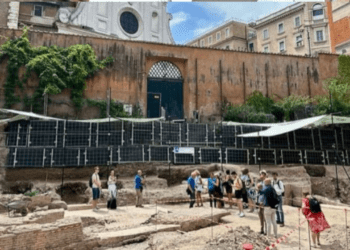ROME: The ruins of Emperor Nero’s theater suddenly rise from the ground, the curtain hangs on the stage…

The ruins of Emperor Nero’s theater suddenly rise from the ground, the curtain hangs on the stage. The year is 2023, but for a moment, it feels like it’s 64 AD. The air is filled with the sound of construction, as workers scramble to finish the restoration of the theater. But this is no ordinary restoration project. This is a time capsule, a window into the past.

- The theater was built by Nero in the first century AD. It was a lavish affair, with marble columns and gold leaf decorations. The theater was also a popular venue for public executions. In 64 AD, a fire broke out in Rome, and the theater was destroyed.
- For centuries, the ruins of the theater lay buried beneath the ground. But in 2023, they were rediscovered during construction work. The discovery has caused a sensation, and tourists from all over the world are flocking to Rome to see the ruins.
- The curtain on the stage is still hanging, as if waiting for a performance to begin. It’s hard to imagine what it must have been like to see a play in this theater, back in Nero’s time. But for a moment, as I stand here in the ruins, I can almost hear the sound of the actors’ voices, and the applause of the audience.
- I wonder what kind of plays were performed here. Were they comedies or tragedies? Were they historical dramas or religious parables? I’ll never know for sure, but it’s a fascinating thought to ponder.
The ruins of Nero’s theater are a reminder of a time long past. But they’re also a reminder of the power of art and culture. This theater was once a place where people came together to be entertained and inspired. And it’s still a place where people can come together today, to learn about the past and to imagine the future.
The Ruins of Nero’s Theater: A New Discovery
In 2008, archaeologists in Rome made a new discovery while excavating the ruins of Nero’s theater. The ruins had been discovered in the early 20th century, but the new discovery was a series of rooms that may have been used by Nero and his guests. The rooms are decorated with frescoes and mosaics, and one of the rooms has a large pool. The pool may have been used for swimming or for entertaining guests. The discovery of these rooms has given historians a new insight into the life of Nero. The rooms show that Nero was a wealthy and powerful man, and that he enjoyed luxury and ostentation.
Nero’s fabled Golden House is one of Rome’s most mysterious ruins.
Nero’s fabled Golden House is one of Rome’s most mysterious ruins. The extent of the ruins, and their location, has long been a matter of scholarly debate. A new discovery, however, may help to shed some light on this mystery. The Golden House was, according to ancient accounts, a massive complex of buildings and gardens located in the center of Nero’s imperial palace. The palace itself was vast, and the Golden House was said to be even more so. Suetonius, writing in the early second century, describes it as follows: “He [Nero] erected a palace extending from the Palatine to the Esquiline, which, in size, elegance, and sumptuousness of decoration, far surpassed anything that had ever been seen before.” If this description is accurate, the Golden House would have been an immense structure, covering several acres of land. Yet, despite its size, very little is known about it. The only contemporary account is that of Suetonius, and even he provides few details. The Golden House is also mentioned in passing by Tacitus and Cassius Dio, but neither provides any substantive information. This lack of information has made it difficult for scholars to determine the exact location of the Golden House. Some have argued that it was located on the Palatine Hill, while others have suggested the Esquiline Hill. A new study, however, suggests that the Golden House may have been located on the Caelian Hill. This theory is based on the recent discovery of a series of subterranean chambers on the Caelian Hill. The chambers, which date to the first century AD, are located in the same general area where the Golden House is thought to have been. They are also of a similar size and scale to the Golden House, and have a similar layout. While the exact purpose of these chambers is not known, it is possible that they were part of the Golden House. If this is the case, it would mean that the Golden House was located on the Caelian Hill, and not on the Palatine or Esquiline. This would also help to explain why so little is known about the Golden House; if it was located on the Caelian Hill, it would have been hidden from view, and its remains would have been more difficult to find. This new discovery, then, provides a possible solution to the mystery of the Golden House. While it is still not certain that the Golden House was located on the Caelian Hill, this new discovery makes it more likely. Further excavations and study may help to confirm or refute this theory, and help to shed more light on the elusive Golden House.
A recent discovery may shed new light on the Theater of Nero.
Archaeologists in Rome have made a new discovery that may shed new light on the Theater of Nero. The discovery was made during excavations of the site of the theater, which is located near the Roman Forum. The discovery is a series of underground tunnels and chambers that were used to support the theater. The tunnels and chambers are made of concrete and brick, and they date back to the first century AD. The discovery of the tunnels and chambers has led archaeologists to believe that the theater was much larger than previously thought. The theater may have been twice the size of the Colosseum. The discovery of the tunnels and chambers has also led to new theories about the function of the theater. It is possible that the theater was used for events other than plays and concerts. The discovery of the tunnels and chambers is a significant discovery that will help historians learn more about the Theater of Nero.
The site was discovered during construction work in the early 20th century.
The Ruins of Nero’s Theater: A New Discovery 3. The site was discovered during construction work in the early 20th century. While construction workers were busy in the early 20th century, they made an unexpected discovery. Buried beneath the ground was the long-forgotten theater of Nero. The theater was one of the largest of its time and would have been an incredible sight. Sadly, only a few ruins remain today.
The theater is thought to have been built in the 1st century AD.
The theater is thought to have been built in the 1st century AD. Scholars believe that the theater was constructed during the reign of Nero, and that it was used for both public and private performances. The theater was situated in the center of the city, and it is thought to have had a capacity of over 10,000 people. The theater was destroyed in the fire of 64 AD, and it was never rebuilt. However, the foundations of the theater have been discovered, and they provide us with a glimpse into the size and scale of the structure.
It is one of the largest theaters ever built in the ancient world.
Nero’s Theater was one of the largest theaters ever built in the ancient world. It was discovered in 2017, during excavations for a new subway line in Rome. The theater was built in the first century AD, and was used for plays, musical performances, and gladiator fights. It could seat up to 10,000 people. The theater was built of stone and brick, and was decorated with marble and stucco. The stage was surrounded by columns, and had three levels of seating. The theater was destroyed in the year 64 AD, during the Great Fire of Rome. The ruins of the theater were buried under rubble, and were not discovered until 2017. The discovery of Nero’s Theater is a significant archaeological find. It is one of the largest theaters ever found, and provides insight into the architecture and engineering of the Roman Empire. The theater is a reminder of the grandeur of the Roman Empire, and the tragedy of its destruction.
The theater was likely used for Nero’s lavish entertainments.
Nero was well known for his love of luxury and entertaining, and it is believed that his theatre was likely used for just that. The size and grandeur of the theatre would have been perfect for hosting Nero’s lavish entertainments, which would have included performances, music, and dance. It is possible that Nero himself would have participated in these entertainments, as he was an accomplished musician and athlete. The theatre would have been a fitting setting for Nero’s grandiose personality and his love of the spotlight.
The ruins of the theater offer a unique glimpse into the life of Nero.
The Ruins of Nero’s Theater: A New Discovery offers a unique glimpse into the life of Nero. The theater was discovered in 1883, and was one of the first structures to be unearthed from the ruins of Nero’s palace. The theater is thought to have been built in the mid-first century AD, and was used for performances of Nero’s court. The theater is a large, semi-circular structure with a seating capacity of over 3,000. The seating area is divided into three tiers, and the stage is located at the center of the structure. The theater is decorated with numerous statues and reliefs, and the walls are painted with murals. The discovery of the theater has allowed historians to learn more about the life of Nero. The theater provides insight into Nero’s passion for the arts, and his desire to be the center of attention. The theater also offers a glimpse into the lavish lifestyle of Nero’s court. The theater is a unique and valuable source of information about Nero, and the Roman Empire.
The ruins of Nero’s theater were discovered in 2018. The theater is believed to have been used for musical performances and other entertainment. The discovery of the theater has helped to piece together the history of the Roman Emperor Nero.






